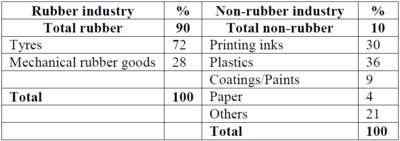Information about carbon black
Back to Subsection DG chemicals
Application of carbon black
While carbon black was exclusively used as a pigment until the beginning of this century, its use as an active filler in rubber was the starting point for a new rapidly expanding application. In automobile tyre production, it was found that treads filled with carbon black had a markedly higher abrasion resistance than those filled with zinc oxide. This discovery, together with increasing use of motor vehicles, was the basis for the present importance of carbon black as a filler in rubber. Today, at least 35 different grades of carbon black are used as fillers in rubber, and about 80 grades are used in pigments or special applications [47, InfoMil, 2002]. Table 1 shows the fields of application of carbon black.
Table 1: Breakdown of total carbon black sales according to the fields of application [47, InfoMil, 2002]
Approximately 90 % of all carbon black sales are to the rubber industry [47, InfoMil, 2002]. However, while the major portion of carbon black is sold to the tyre industry, carbon black is also used by the automotive and the rubber industries in general as a major component in the production of mechanical rubber goods. Carbon black production is, therefore, largely dependent on developments in the automotive industry.
The remaining 10 % of carbon black sales are to the non-rubber industry. Carbon black is used by the printing industry (for pigment blacks in printing inks) and by the plastic industry. These sectors consume roughly one-third each of the total pigment black sales. A further important application, especially for the higher priced, fine particle size carbon blacks, is in the production of black coatings/paints, which accounts for approximately 9 % of production. This is followed by the paper industry, accounting for approximately 4 %. Other non-rubber areas are, for example, the manufacture of electrodes and the reduction of metal oxides. Together, these applications have a share of about 21 % of total non-rubber carbon black sales.
About 90 % of the carbon black produced is used by the rubber industry as a reinforcing filler in tyres, tubes, conveyor belts, cables, rubber profiles, and other rubber goods. Furnace blacks are predominantly used in rubber processing. Fine particle size carbon blacks (reinforcing blacks) are used for the production of rubber mixtures with high abrasion resistance (e.g. tyre treads). Coarser carbon blacks (semi-reinforcing blacks) are used in rubber mixtures requiring low heat build-up and resistance to permanent deformation during dynamic stress (e.g. carcase compounds, equipment mountings, and seals). Extremely coarse carbon blacks (non-reinforcing blacks) are incorporated into mixtures with high elasticity and good extrusion properties.
Quantitatively, the pigment blacks are substantially less important than the rubber blacks. They are used for the manufacture of printing inks, colouring plastics, fibres, lacquers, coatings, and paper. Oxidised carbon blacks are frequently used in the printing ink and coating industry. While high-colour gas blacks are still predominant in lacquers and coatings, furnace blacks are becoming more and more important in plastics, coatings, and printing inks. Besides their two main uses as reinforcing fillers and pigments, small amounts of carbon blacks are used by the electrical industry to manufacture dry cells, electrodes, and carbon brushes. Special blacks are used to give plastics antistatic or electrical conduction properties. Another application is the UV stabilisation of polyolefins.
Back to Subsection DG chemicals
